Thursday, 29th July 2021
Making Water Sensitive Cities in Ganga Basin
In News
A new capacity building initiative on ‘Making water sensitive cities in Ganga basin’ aimed at improving river health/flows was launched by National Mission for Clean Ganga (NMCG) in association with Centre for Science and Environment (CSE).
Details of the Initiative
- This is the first of its kind capacity building program. The aim of the program is capacity building and action research for promoting sustainable urban water management for improved river health in Ganga basin cities.
- The program will engage all the stakeholders which includes, SPMGs (State Program Management Group, Namami Gange), Municipal corporations, Technical & research constants, international organizations and local grassroot communities.
- Key focus areas of the programme will be Water Sensitive Urban Design and Planning (WSUDP), Urban Water Efficiency and Conservation, Decentralized Wastewater Treatment and Local Reuse, Urban Groundwater Management and Urban Waterbodies / Lake Management.
- Initially, the project will be implemented in 3-4 pilot cities in the Ganga basin. Technical support will be provided to urban local bodies (ULBs).
- This initiative is part of the series of ongoing efforts by NMCG aimed to ensuring convergence of the Namami Gange Mission with national flagship urban missions (AMRUT, Smart Cities, Swachh Bharat Mission, HRIDAY, NULM) and other missions (Atal Bhujal Yojana, Jal Jeevan Mission, Jal Shakti Abhiyan) at state /city level across Ganga basin states.
Water sensitive city- Challenges of Water Management in Cities
Many cities face three critical challenges in managing water resources, waterways, river basins and coastal environments, and ultimately people’s quality of life:
- Rapidly growing population with changing lifestyles and values: Population growth increases the pressure on water resources, with water scarcity and pollution posing the greatest risks.
- Changing and highly variable climate: Climate change is resulting in more extreme weather events such as floods, heatwaves, increasing periods of drought, and more frequent and intense storms and cyclones that can lead to loss of life while adding extra pressure on our water-related infrastructure and homes located in vulnerable places.
- Challenging economic environment: When cities and towns are constructed, the natural landscape is dramatically altered: vegetation and soil are replaced with hard, impervious surfaces and buildings. This leads to the development of unique urban climates that are quite different from those of surrounding natural environments. The common results: an increase in air pollution, modified rainfall patterns, and higher air temperatures.
What makes cities water sensitive?
In a water sensitive city, we interact with the urban water (hydrological) cycle in ways that:
- provide the water security essential for economic prosperity through efficient use of diverse available resources
- enhance and protect the health of waterways and wetlands, the river basins that surround them, and the coast and bays
- mitigate flood risk and damage
- create public spaces that collect, clean, and recycle water
Sources:
Important Bills in the Parliament and their Status – as on 28 July 2021
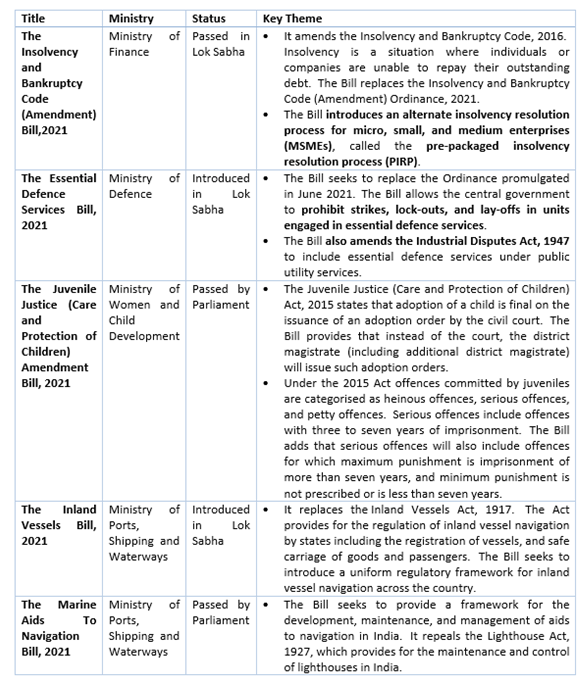
Sources-
- The Insolvency and Bankruptcy Code (Amendment) Bill, 2021
- The Essential Defence Services Bill, 2021
- The National Bank for Financing Infrastructure and Development (NaBFID) Bill, 2021
- The Juvenile Justice (Care and Protection of Children) Amendment Bill, 2021
- The Inland Vessels Bill, 2021
- The Marine Aids To Navigation Bill, 2021
Challenge to Restitution of Conjugal Rights
In News: The Supreme Court will be hearing a fresh challenge to the provision allowing restitution (recovery) of conjugal rights under Hindu personal laws (Hindu Marriage Act, 1955).
What are Conjugal Rights?
- Conjugal rights are rights created by marriage, i.e. right of the husband or the wife to the society of the other spouse.
- The law recognizes these rights - both in personal lawsdealing with marriage, divorce etc, and in criminal law requiring payment of maintenance and alimony to a spouse.
- Section 9 of the Hindu Marriage Actrecognizes one aspect of conjugal rights - the right to consortium and protects it by allowing a spouse to move court to enforce the right.
Origin of Restitution of Conjugal Rights
- The concept of restitution of conjugal rights is codified in Hindu personal lawand has colonial origins.
- Originating from Jewish law, theprovision for restitution of conjugal rights reached India and other common law countries through the British Rule.
- Similar provisions exist in Muslim personal law as well as the Divorce Act, 1869, which governs Christian family law.
- Incidentally, in 1970, the U.K repealedthe law on restitution of conjugal rights.
Reason for Challenging the Law
- Violation of Rights: The law is being challenged now on the main grounds that it violates the fundamental right to privacy as restitution of conjugal rights amounted to a “coercive act” on the part of the state.
- Biased Against Women: Women are often called back to marital homes under the provision, and given that marital rape is not a crime, leaves them susceptible to such coerced cohabitation
- Not in Consonance with SC Judgements: In the recent judgement of Joseph Shine v Union of India 2019, the SC has put great emphasis on the right to privacy and bodily autonomy of married women, stating that marriage does not take away their sexual freedom nor choice to which the restitution of conjugal rights seem to be not abiding.
- Misuse of the Provision: Another pertinent matter to take into consideration is the misuse of this provision as a shield against divorce proceedings and alimony payments. Often an aggrieved spouse files for divorce from their place of residence and their spouse retaliates by filing for a decree of restitution in their place of residence.
Source:
Covid-19 and Vaccine Hesitancy
In News
Vaccine hesitancy, particularly in India's vast hinterlands, could put the country’s fragile gains against COVID-19 at risk.
About the News
- Four in 10 unvaccinated adults above the age of 70 were hesitant to take the shot against the coronavirus disease (Covid-19), a survey commissioned by the government has said, highlighting the need for effective messaging on the ground among the target population group.
What is Vaccine Hesitancy?
- According to the World Health Organisation, vaccination hesitancy refers to the delay in acceptance or refusal of vaccines despite the availability of vaccine services. It is influenced by factors such as complacency, convenience, and confidence.
- Vaccine hesitancy is not a recent phenomenon. It is neither limited to a particular community or country, nor have we seen it only in the context of COVID-19. Vaccine hesitancy is complex and context-specific, varying across time, place, and vaccines.
- From a public health and equity perspective, this is a cause for worry. There are many diverse factors at play in this, which may go beyond the health concerns and have more to do with socio-anthropological aspects of health-seeking behaviour.

Reasons for Vaccine Hesitancy
- Lack of Awareness: Lack of awareness causes people to have low-risk perception of Covid-19, develop fear of any side-effects, and doubt the efficacy of vaccines. Vaccine hesitancy is also driven by cultural nationalism. Most of the promotions of traditional medicinal systems tread a fine line between calling something a ‘cure’ and calling it an ‘immunity booster’, and it is easy to get confused.
- Fears based on inaccurate information: Although internet can be a great tool for self-education, it also presents several challenges in the form of misinformation (including ‘anti-vaxx’ messaging) and incomplete information, as well as inconsistent and complicated scientific information that may be difficult to understand.
- Socio-Cultural Context: Most of people’s fears and apprehensions stem from a deep impact of something adverse or unfavourable that they have personally experienced, or our social circles have experienced. Over time these become their beliefs and innate guards. These individuals, and the communities they belong to, are probably not really challenging medical science, or questioning vaccine trial results, adequacy or inadequacy of evidence. Rather, they seem to indicate deep-seated fears and belief in conspiracies, the fear of perhaps being discriminated and deceived and of being omitted (from societal benefits).
What can be done about it?
- Responsible and correct information dissemination: Reporting of adverse events after immunization is a key component of monitoring the implementation of vaccination programs.
- The media should therefore report in a responsible and transparent manner, providing clear and unbiased information to its audiences.
- People using the internet and social media (including scientists and clinicians) should do so responsibly to avoid spreading falsehood.
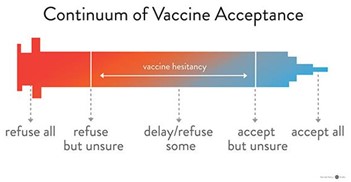
- Awareness Campaigns: Aggressive awareness campaigns through posters and radio announcements to allay some of the anxiety and confusion and conducting door-to-door surveys to encourage people to get the jab. Let people know how vaccines work, how they help prevent a disease, what the probable side effects are and how they can be managed.
- Targeting Behavioural Aspects: Overcoming Covid-19 vaccine hesitancy will require a target-based approach. Individuals are time-inconsistent, i.e., they are more concerned about the present as compared to some distant future event. The benefits of the vaccines will accrue in the future; however, the cost of vaccines, fear of immediate side-effects, inconvenience, time and money spent etc., have to be borne in the present. Therefore, the strategies to overcome hesitancy have to target the present through adequate incentives and timely information.
- Compensation and Incentives: Given that a large proportion of the rural population works as daily wagers and fears losing a day’s income due to vaccination, workers may be given one-day MGNREGA wage for taking the shot. Small incentives, (1kg rice and pulses, 1 litre of cooking oil, etc) can be given to compensate people for the time and money they spend to get the vaccine.
- Building Trust and Confidence: Sustained and meaningful efforts need to be made to build trust, gain confidence of communities and meet their expectations. This would also require seeing them as equals, treating them with dignity and acknowledging their fears. They will also need to rethink and alter their communication strategies and move beyond ceremonial awareness drives and campaigns to interventions that are truly engaging and which make the communities feel important and valued.
- Community Participation: Even more crucial is to engage communities in planning, execution and monitoring of health care services at all levels. Create fora where they can freely convey what they want and how they want it to be delivered, where they can share how they feel about government policies, programmes or services and where they can hold people and systems accountable for gaps without the fear of being subjugated.
Conclusion
Vaccine hesitancy poses a risk to ending the pandemic in India. The more the virus circulates, the more it can mutate into dangerous new variants that can undermine vaccines. Understanding vaccine hesitancy and addressing it is important to prevent avoidable deaths and health problems, to get on with normal life and for the economy to function at full capacity. The threat to life, livelihoods and health is not going to be over until at least 70-80 per cent of the population is immunised and herd immunity is achieved.
Question: What is Vaccine Hesitancy and how is it caused? Discuss the steps that can be taken to overcome vaccine hesitancy.
Sources:
- Understanding COVID-19 vaccine hesitancy
- Vaccine hesitancy puts India's gains against coronavirus at risk
- India has a vaccine hesitancy challenge
- Addressing vaccine hesitancy
- Vaccine hesitancy may bend your career graph
- Why some people don't want a Covid-19 vaccine
- Tackling vaccine hesitancy challenge in rural India
- How India can combat vaccine hesitancy
- All you wanted to know about vaccine hesitancy
- Why Are People Hesitant To Take The Covid Vaccine?
This Day in History - International Tiger Day
On July 29, 2010, several countries became signatories to an agreement at the Saint Petersburg Tiger Summit in Russia. Since then, International Tiger Day is celebrated on July 29 to raise awareness about the conservation of the wild cat, which over the last 150 years has witnessed a massive drop of nearly 95% in its population. India accounts for nearly 70% of the world's total tiger population and has already achieved the target of doubling its numbers. India is home to 51 tiger reserves located across 18 states. The tiger census of 2018 showed an increase in the population of India's national animal. The theme for the 2021 International Tiger Day is “Their survival is in our hands”.

Source:
Image of the Day - Sandstorm
This is the image of the sandstorm from Gobi Desert, which created dangerous driving conditions in the area. A heavy sandstorm with dust clouds towering at least 100 metres (330ft) high hit Dunhuang city in Gansu Province recently. A sandstorm is described as a natural phenomenon that occurs when a strong wind, such as a gust front, blows fine sand particles and dust from a dry surface. These particles become suspended in the air, causing erosion where they initially were. The wind drops these particles in another place where silt is formed.

Sources:
Nauka Module of Russia
- Context: Russian Space Agency Roscosmos has launched Nauka to the International Space Station (ISS).
- Nauka, meaning "science" in Russian, is the biggest space laboratory Russia has launched to date.
- It will primarily serve as a research facility fitted with oxygen generator, a spare bed, another toilet, and a robotic cargo crane built by the European Space Agency (ESA) for the Russian astronauts.
- The new module was sent into orbit using a Proton rocket - the most powerful in Russia’s space inventory.

Source:
- Explained: What is Nauka, the module Russia is sending to International Space Station?
- Russia sends long-delayed module to space station
Image Source:
Global Internet Forum to Counter Terrorism
- Context: Global Internet Forum to Counter Terrorism (GIFCT) is significantly expanding the types of extremist content shared between firms in a key database, aiming to crack down on material from divisive elements and organizations.
- GIFCT is an NGO designed to prevent terrorists and violent extremists from exploiting digital platforms.
- Founded by Facebook, Microsoft, Twitter, and YouTube in 2017, the Forum was established to foster technical collaboration among member companies, advance relevant research, and share knowledge with smaller platforms.
Source:
Exercise INDRA 2021
- Context: The 12thEdition of Indo-Russia joint military Exercise INDRA 2021 will be held at Volgograd, Russia in August 2021.
- INDRA series of exercise began as a biennial bilateral maritime exercise between Indian and Russian Navy in 2003.
- Later, the joint exercise assumed a tri-services scope with corresponding maturity and gradual increase in scope, complexity, and level of participation.
- INDRA 2021 will entail conduct of counter terror operations under the United Nations mandate by a joint force against international terror groups.

Source:
Image Source:
National Organ Transplant Program (NOTP)
- Context: The Government of India is implementing National Organ Transplant Program (NOTP).
- It aims to promote organ donation and transplantation across all States/Union Territories (UTs).
- The basic provisions of this program include:
- Setting up of State Organ and Tissue Transplant Organizations (SOTTOs) in each State/UT.
- Setting up of National/ Regional/State Bio-material centers.
- Financial support for establishing/strengthening new organ transplant/retrieval facilities.
- Training of transplant experts.
- Post-transplant immune-suppressant drugs to certain patients.
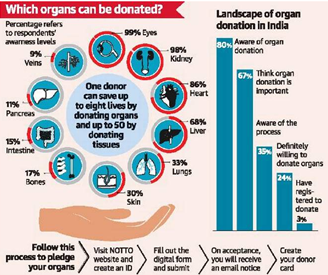
Source:
Image Source:
How NEP can transform higher education in India
Essence: Higher Educational Institutions in India (HEIs) have shown a consistent growth in both the quality and the quantity of research in the past decade. Of three aspects — education, knowledge generation (research and development) and innovation — Indian HEIs are lacking on the innovation front. National Education Policy (NEP) is expected to transform the landscape of higher education in India in the specific ways. Until now, Indian HEIs lacked international diversity and remained predominantly local. But NEP has enabled mechanisms to venture out and open international campuses across the world. This will not only increase their international footprint but also improve their perception globally.
Why should you read this article?
- To get an overview of HEIs in India and issues associated with the same.
To understand how NEP will help in transforming the landscape of higher education in India.
Source:
Farm reforms must be oriented towards minimising risk and increasing returns for farmers
Essence: The article opines that it has been a good initiative to keep India away from nationalization of farm sector but indirect control of the government in rural property rights, land use and land ceilings; commodity prices, input subsidies and taxes, infrastructure, production, credit, marketing and procurement, public distribution, research, education and extension services, trade policy and agri-business have held the sector from attaining actual potential.
The article points towards risk to return of 4 crops- wheat, rice, maize and cotton in green revolution states and rest of India. It concludes that the whole ecosystem is risk-averse and hence caught in a vicious trap. Also, uneven distribution of common goods across the country, following of fragmented agricultural practices have led to wider deficit in agricultural practice. Agricultural reforms are the urgent need of the hour.
Why you should read this article?
- To understand the progress of agriculture as an economic activity post-independence
- To guage how agriculture is under the influence of government restrictions
- To understand the key points for urgent reforms in agriculture sector
Source:
A judgment that must be taken in the right spirit
Essence: Editorial is covering the arguments pertaining to recent decision of SC on 97th constitutional amendment (cooperative societies).
The 97th constitutional amendment came into effect from 2012 and brought about many changes to the legal regime of cooperative societies.
Union of India vs Rajendra N. Shah, a judgment delivered by the Supreme Court of India in July 2021, struck down the amendment, on the grounds that it had failed to comply with the requirements under Article 368(2) by virtue of not having been ratified by the States.
The court noted that the judgment is confined to the procedural lacuna and does not go into the question of the amendment being violative of the basic structure of the Constitution.
The cooperative sector has always been in the domain of the States or provinces. The organising principles and mechanism of these cooperatives differ from area to area and depend on the industry or crop which forms the fulcrum of the cooperative. Homogeneity in this area would only result in the creation of round holes in which square pegs no longer fit.
Why you should read this article?
- To understand the reasoning of SC, behind recent decision on 97th amendment act.
- To gain insights into constitutional status of cooperative sector.
- To know about the implications of union control over cooperative sector.
Source:
What is success?
Background
- Simone Biles, the 25-year-old defending champion of the individual all-around gymnastics title decided to forego the chance to go for Olympic win, prioritising her mental well-beingover medal success.
What is important- mental well-being or materialistic tendencies?
- Simone Biles’s decision is a brave step and it shows courage.
- It is important to give priority to mental well-being as it is important parameter for maintaining social well-being, health and self-esteem.
- Many people believe that wealth and materialism is a fast track to happiness. But it's not true.
- Believing that money is the key to happiness can also harm a person's well-being.
- For example, a person who chooses to work a lot of overtime misses out on time with family, friends, and leisure activities.
Significance of this case
- Performance pressure among youth to be successful in life
- Increasing materialistic tendencies in society
Where to use it?
- Upsc Previous year paper (2016): GS 4: Explain how ethics contributes to social and human well-being.
- Upsc Previous year paper (2017): GS 4: The crisis of ethical values in modern times is traced to a narrow perception of the good life. Discuss.
Source:
Share the article
Get Latest Updates on Offers, Event dates, and free Mentorship sessions.

Get in touch with our Expert Academic Counsellors 👋
Frequently Asked Questions
UPSC Daily Current Affairs focuses on learning current events on a daily basis. An aspirant needs to study regular and updated information about current events, news, and relevant topics that are important for UPSC aspirants. It covers national and international affairs, government policies, socio-economic issues, science and technology advancements, and more.
UPSC Daily Current Affairs provides aspirants with a concise and comprehensive overview of the latest happenings and developments across various fields. It helps aspirants stay updated with current affairs and provides them with valuable insights and analysis, which are essential for answering questions in the UPSC examinations. It enhances their knowledge, analytical skills, and ability to connect current affairs with the UPSC syllabus.
UPSC Daily Current Affairs covers a wide range of topics, including politics, economics, science and technology, environment, social issues, governance, international relations, and more. It offers news summaries, in-depth analyses, editorials, opinion pieces, and relevant study materials. It also provides practice questions and quizzes to help aspirants test their understanding of current affairs.
Edukemy's UPSC Daily Current Affairs can be accessed through:
- UPSC Daily Current Affairs can be accessed through Current Affairs tab at the top of the Main Page of Edukemy.
- Edukemy Mobile app: The Daily Current Affairs can also be access through Edukemy Mobile App.
- Social media: Follow Edukemy’s official social media accounts or pages that provide UPSC Daily Current Affairs updates, including Facebook, Twitter, or Telegram channels.

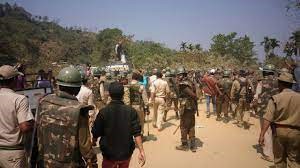

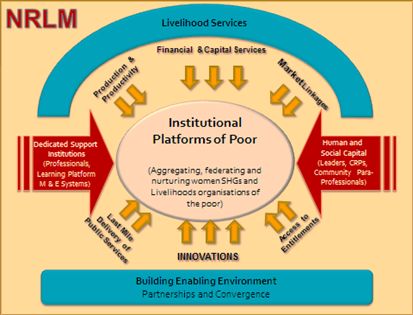
![Production-linked Incentive (PLI) Scheme for Specialty Steel • Digital Rupee • Renewable Energy Certificate (REC) Mechanism • This Day in History - Bal Gangadhar Tilak • Image of the Day – King Cobra • Project 75 (India) [P-75(I)] • Harela Festival • Avian Flu/ H5N1 • Expanding India’s foreign policy canvas – Hindustan Times • Bangladesh's Microfinance: Case study for reducing poverty](https://edukemyprodstorage.blob.core.windows.net/edukemy-v2-assets-public/newsletter-images/1627053778blobid1627053773170.jpg/6qOdfWHokMxecfCInlsNiohdzUmiiR170zseon9s.jpg)

